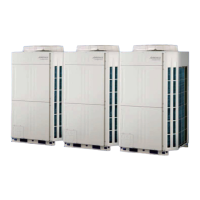
Do you have a question about the Fujitsu Airstage VR-II Series and is the answer not in the manual?
| Cooling Capacity | Varies by model |
|---|---|
| Heating Capacity | Varies by model |
| Energy Efficiency Ratio (EER) | Varies by model |
| Coefficient of Performance (COP) | Varies by model |
| Indoor Unit Dimensions (WxHxD) | Varies by model |
| Outdoor Unit Dimensions (WxHxD) | Varies by model |
| Indoor Unit Weight | Varies by model |
| Outdoor Unit Weight | Varies by model |
| Airflow Direction | Auto, Manual |
| Filter Type | Washable |
| Remote Control | Yes |
| Wi-Fi Control | Optional |
Outlines critical steps and precautions before and during system execution for proper installation.
Details essential checks and inspections required for the system before applying power to ensure safety and functionality.
Lists critical checks and inspections to be performed on the system after power has been applied.
Explains the procedure for conducting a test run of the system using the outdoor unit's PC board.
Details how to control and manage the test run operation, including signals from various controllers.
Provides a list of settings and functions that can be configured for the outdoor unit via field adjustments.
Lists configurable field settings and functions for various types of indoor units, managed via remote controller.
Details field settings and functions specific to the outdoor air unit, including temperature triggers and auto restart.
Illustrates the refrigerant flow path and lists all components within the outdoor unit's refrigerant circuit.
Provides a comprehensive list of all input signals and output controls for the system, detailing their function and range.
Explains how heat recovery operation is controlled, including mode selection and heat balance management.
Details the conditions and modes under which the compressor operates and stops, including protection features.
Describes how heat exchanger capacity is managed through operation modes, fan control, and EEV adjustments.
Explains the fan speed control logic for cooling and heating operations, including conditions affecting fan speed.
Details the control range and operation of the electronic expansion valves (EEVs) in different modes.
Covers special operational modes like Oil Recovery, Pre-heat, Defrost, Low noise, and Snow Falling protection.
Lists various protective functions for the system, detailing detected devices, conditions, and operations for each protection.
Explains fan speed settings and the "AUTO" position logic for cooling, heating, and dry operations.
Details the master control logic for different indoor unit connectable types, covering mode settings, cool/dry/heat modes, and stop modes.
Provides instructions for adjusting vertical and horizontal airflow direction and swing operations using the remote controller.
Explains the initialization, operation control, and special control logic for electronic expansion valves.
Describes the operation of the drain pump, including its start, continuous operation, and response to float switch signals.
Covers essential unit functions such as Auto Restart, Freeze Prevention, Oil Recovery/Defrost Operation, and Outdoor temperature protection.
Details the components and layout of the RB unit, including solenoid coil positions, valve positions, and PCB layouts.
Explains the normal operation indicators and patterns for the indoor unit display, including LED and 7-segment displays.
Details how error codes are displayed, including subsection and specific error codes, and troubleshooting procedures for communication errors.
Provides basic troubleshooting steps for network communication abnormalities, including checking terminal resistance and using the address checker.
Explains the backup operation procedure for replacing a compressor or when a unit is defective.
Offers diagnostic methods for compressor issues and lists relevant service parts for troubleshooting.
Presents the refrigerant circuit diagrams for different outdoor unit models, showing component connections and flow paths.
Provides detailed wiring diagrams for various indoor unit types, including compact cassette, slim duct, and wall-mounted units.
Details the procedures for removing and installing the transmission PCB on indoor units, including DIP-SW settings.
Outlines the steps for accessing and removing external panels and covers of the outdoor unit for servicing.











